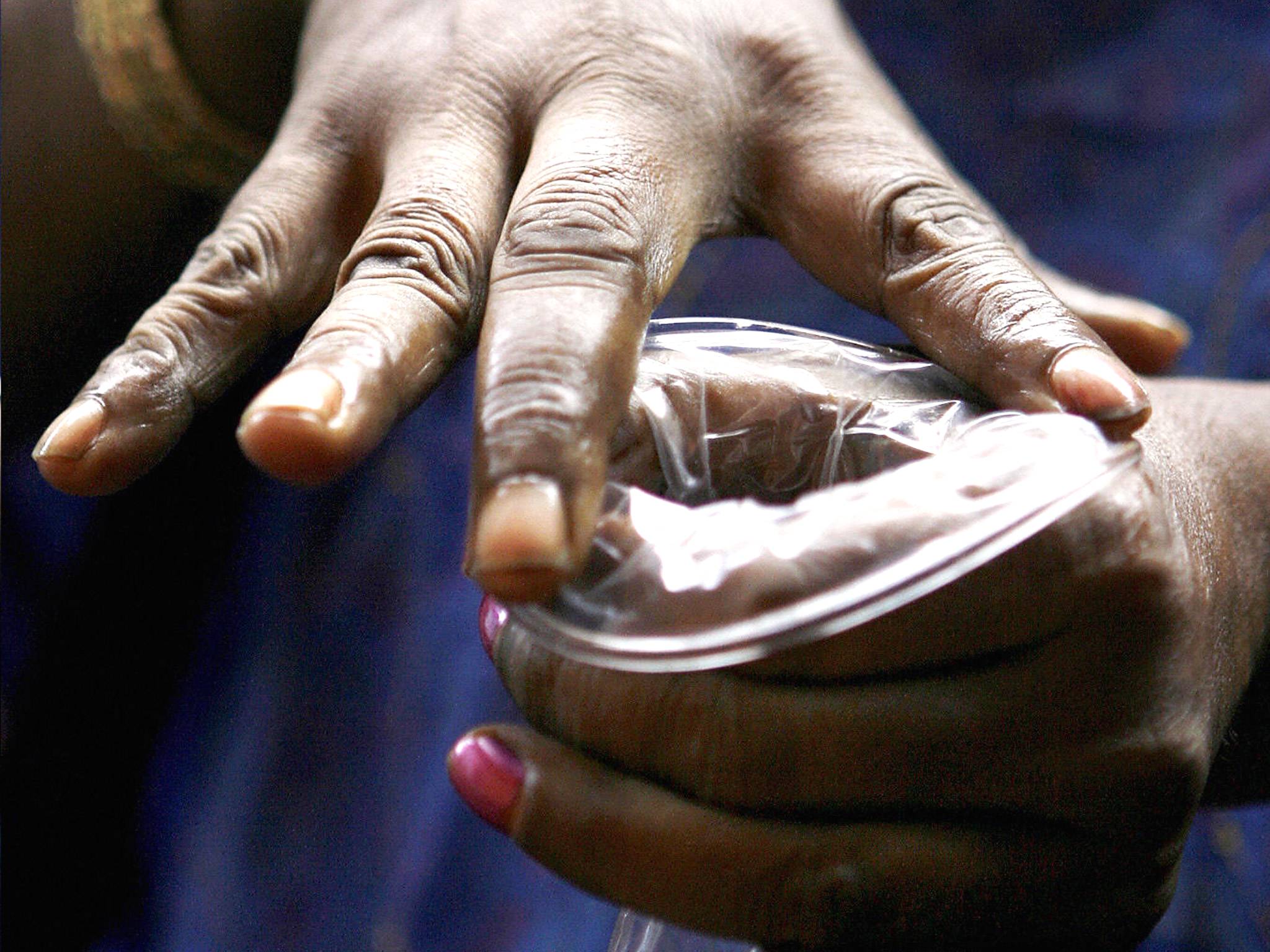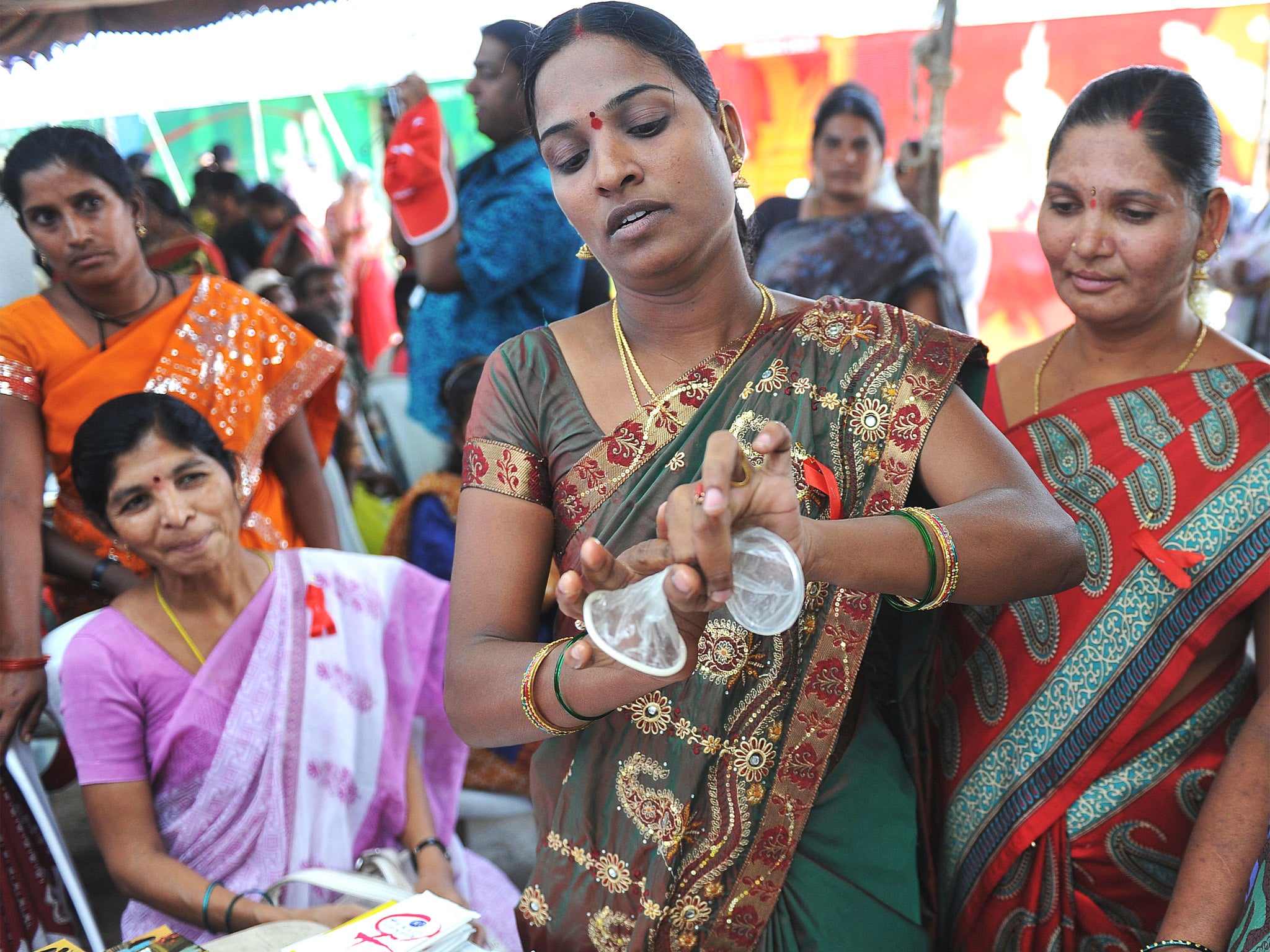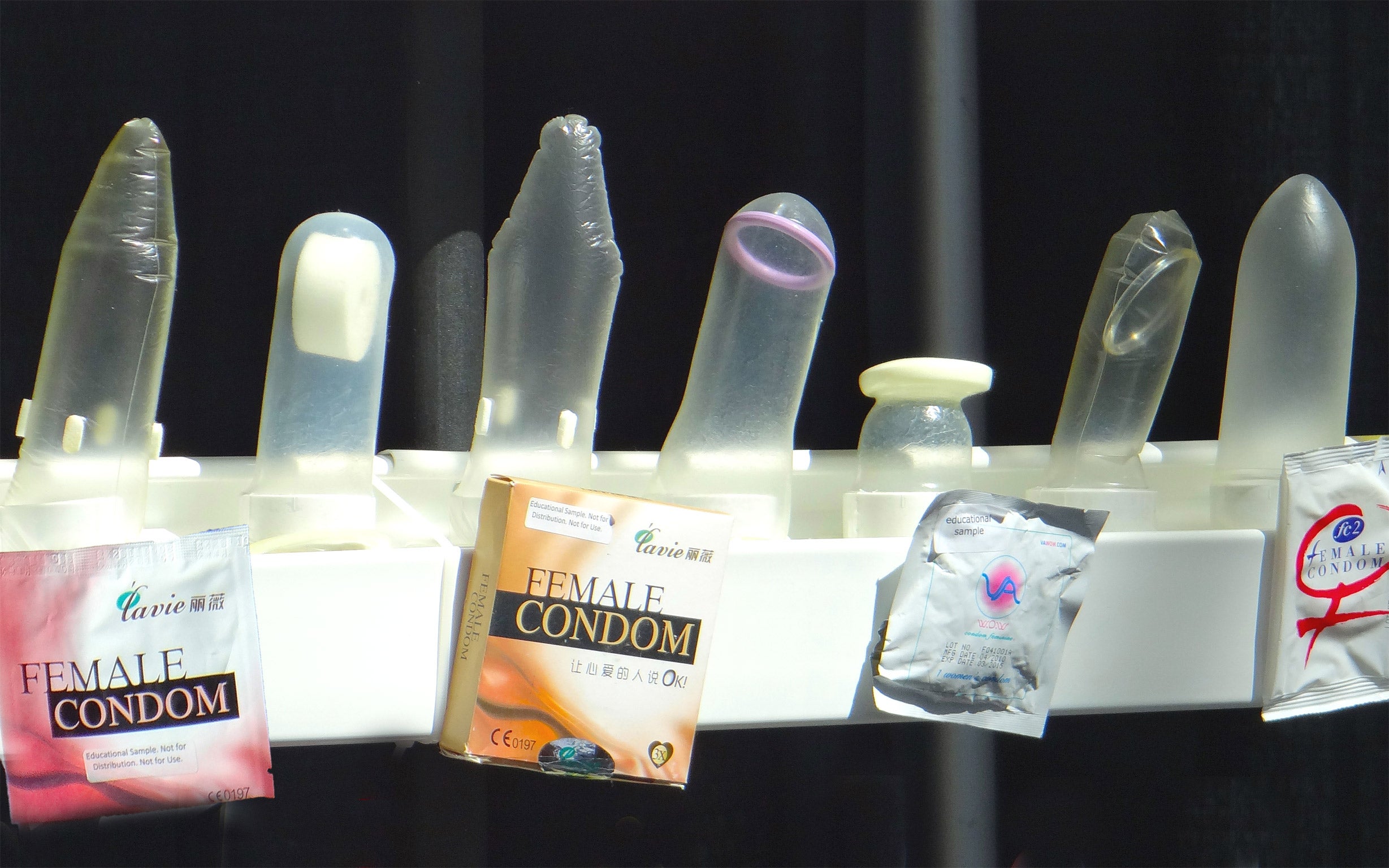The future of sex: The first female condoms were derided, mistrusted and shunned - but will their modern counterparts catch on?

In 1987, an American pharmaceutical executive called Mary Ann Leeper flew to Copenhagen to get a first-hand look at what she thought might be the world's next great health innovation. She didn't expect to find it tucked away inside an old cigar box.
When she arrived at the old farmhouse owned by Lasse Hessel, a Danish doctor and inventor, he opened the door with a cigar in his mouth. Then he fetched the box. "Inside were all these bits and pieces – metal, plastic, all different kinds of stuff," Leeper recalls. "I took a deep breath and thought, 'Holy Mother – what have I got myself into?'"
Somehow, these bits and pieces fit together to form a contraption that women could wear during sex to prevent pregnancy and sexually transmitted infections – the world's first female condom. The presentation may have been unconventional, but Leeper and her colleagues at Wisconsin Pharmacal had high hopes for Hessel's invention. "The Aids crisis in the United States was just fully being recognised, and it was clear to us that for women to have a product that they could use to help protect themselves would be a good thing," Leeper says.
When Wisconsin Pharmacal finally introduced the female condom to the US in 1993, public-health experts hailed it as a game-changer. Called the FC1, the condom, a polyurethane pouch inserted into the vagina before sex, would protect women from sexually transmitted infections even if their male partners refused to wear condoms. Used correctly, it reduces a woman's risk of contracting HIV by 94 to 97 per cent.
Yet, two decades after its much-celebrated introduction, the female condom still isn't living up to its potential. Less intuitive and familiar than the male condom, the device simply never caught on. Journalists mocked it, clinicians ignored it, and women shunned it, claiming that the condom was aesthetically unappealing and technically difficult to master. Today, only 1.6 per cent of all condoms distributed worldwide are of the female variety.
Now, an assortment of redesigned and reinvented female condoms are beginning to make their way on to the market.
From the start, the female condom was a difficult project . The challenge, in part, was the era, and the public's squeamishness about a sex-related product. Although the Aids crisis was raging, for many American women, the risk of contracting HIV was abstract, something that happened to other people and not to them. While women in focus groups had said they liked the idea of the condom, according to Leeper, "when they were in that bedroom, the female condom was out on the dining-room table".
There were other barriers, too. The condoms cost as much as $5 (£3) each, compared with male condoms, which can typically be had for $1 or less. What's more, the female condom was, frankly, strange. Unlike the male condom, which is sold rolled up and compressed, the female condom was packed fully open. Women and men alike were turned off by the unfamiliar, big, plastic-bag-like device they found when they undid the packet. Though some women eventually grew to like the condoms, there was a definite learning curve, and as many as one-third to half of women had difficulty inserting them. Once in place, the condom had a tendency to squeak or rustle during sex. As sociologist Amy Kaler recounts in her 2004 paper on the condom's introduction, journalists compared the product to: "a jellyfish, a windsock, a fire hose, a colostomy bag, gumboots, a concertina, a plastic freezer bag, something to line Boston's Inner Harbour with, a cross between a test tube and a rubber glove, Edvard Munch's The Scream, something designed for a female elephant, something out of The Jetsons, a raincoat for a Slinky toy, or a 'contraption used to punish fallen virgins in the Dark Ages'."
Still, there were signs that Wisconsin Pharmacal was onto something. In 1996, it changed its name to the Female Health Company and began to focus on this global public sector, working with governments, health organisations and aid agencies to get the condoms into the hands of at-risk women in low-income countries. They became a particularly important tool in several countries in sub-Saharan Africa, where, in the early 2000s, 60 per cent of new HIV diagnoses were made in women, who often contracted the virus from their long-term partners.

Patience Kunaka, who was teaching nursing and midwifery students in Zimbabwe when she first heard about female condoms, knew these risks all too well. Two of her cousins had died of Aids-related causes, and three other family members were infected with HIV. Like many other women, she was not initially impressed by the female condom. "When I first saw one, my immediate reaction was, 'Wow! How does it remain inside with penile movement?'" she recalls. "I thought it would be sliding in and out and what a messy act! I also thought the plastic would crumble inside me, causing discomfort."
But Kunaka suspected her partner at the time of being unfaithful and was "obsessed about sexual hygiene," so she decided to give the female condom a shot. It didn't go well at first. "I had problems inserting it and felt discomfort from the inner ring," she says. After some practice, she got the hang of it. Kunaka even began to like the device, especially "the fact that I don't have to beg my partner to use a condom".
She became a female-condom convert. "In my African context, where men are at liberty to have as many partners as they can have, they give me power to negotiate for safer sex," she says. She even went on to get a job as the condoms and training manager for Population Service International Zimbabwe, and now spends her days spreading the word to men and women throughout the country.
In some places, the condoms are stigmatised, thanks to clinical trials and distribution programmes that initially focused on sex workers. Elsewhere, the devices are still saddled with the baggage of the product's first, failed introduction. In March 2013, for instance, a writer for Jezebel, a popular feminist blog and news site, published a post entitled "Stop Trying to Make Female Condoms Happen". She expressed scepticism that "women will change their minds about wanting to line their vaginas like a waste-paper basket", and concluded by noting that "female condoms are just ew". More than two decades after the first female condom hit the shelves, this was not exactly the revolution that public-health experts had in mind.
For nearly 40 years, Path, a global health non-profit organisation based in Seattle, Washington, has been radically reinventing basic medical technologies. In the late 1990s, it turned its attention to the female condom. Its advances were inspired by feedback from testers and researchers in Thailand, who said, "Wouldn't it be wonderful if you had some kind of insertion device that helped you insert it and then it got out of the way?"
By 2003, Path had hit on the solution: a dissolving applicator. The engineers created a condom that looked like a funnel, with a thin sheet of polyurethane that narrowed into a rounded tip. This tip contained the main pouch of the condom, collapsed inside a dissolving capsule. To insert the condom, women would simply push the capsule inside, much the same way they would insert a tampon. Once it came into contact with the moisture of the vagina, the capsule would melt away – often within 30 to 60 seconds – releasing the full condom pouch. Limited quantities are already being sold in China and South Africa.
Path's woman's condom isn't the only new one on the scene. In 2012, the United Nations Population Fund (UNFPA) pre-qualified the Cupid, which is manufactured by an Indian condom company. The Cupid relies on a ring-shaped foam sponge tucked into the closed end of the condom pouch for internal stability. Made of natural latex, the Cupid may be the cheapest female condom yet, and is now available.
Several other condoms, each slightly different, are currently under UNFPA review. For instance, the Phoenurse, which is sold in China, has an optional insertion stick. Then there's the Panty Condom, in which a condom pouch is affixed to a pair of reusable knickers with an opening over the vagina. Before sex, a woman can push the condom inside with her finger – or a man can with his penis – without her having to take off the undergarment.
And there are more designs in the early stages of development. Origami Condoms, based in Los Angeles, has developed a silicone female condom that unfolds like an accordion as it is pushed into the vagina. Not every product will be right for every woman or couple, but that's the point. "In the studies we've done, we've found that some women will say, 'I really love this one and I don't like this one at all'," says Mags Beksinska, research director at the division of maternal, adolescent and child health at the University of the Witwatersrand, South Africa. "There are different aspects that appeal to different women in the different designs."
Krissy Ferris, a health worker, was initially turned off by the cost of female condoms, but saw their advantages while dating a man who had trouble maintaining an erection with a male condom. "It was definitely a barrier to male condom use, and I was not ready to compromise on using a barrier method," she says. The female condom was a "low-stress" solution.
There is some evidence to suggest that women are more likely to have safe sex – and less likely to become pregnant or contract sexually transmitted infections – when a larger selection of contraceptive and barrier products is available. Giving women a greater choice in female condoms may increase the odds that they choose any female condom at all.

Meanwhile, male condoms are also undergoing a redesign. In November 2013, the Gates Foundation awarded 11 grants of $100,000 to designers, engineers and scientists with ideas for a "next-generation condom" – male or female – that would be easier and more pleasurable to use. The winning proposals include a male condom that is packaged with a built-in applicator, allowing the condom to be removed from its foil wrapper and donned in a single smooth motion, and a one-size-fits-all male condom designed to tighten during sex.
Of course, upgrading a product is merely a first step. While the FC1 certainly had its flaws, they weren't the only reason that female condoms didn't take off. "Some technologies are more difficult than others," says Laura Frost, a partner at Global Health Insights, a research and consulting firm. "Compared with other products where there's one huge issue, like affordability or awareness, this one had those obstacles at every stage."
That's why, for the female condom to truly be successful, advocates will need to invest in comprehensive marketing and education campaigns at local, national and global levels. "It takes more than just putting it on the shelf," says Susie Hoffman, an associate professor of epidemiology at Columbia University in New York.
Female condoms remain less straightforward than male condoms, and one of the major lessons of the past two decades is that women often need a little bit of training to use them correctly. That means that clinicians and counsellors may have to do more than simply tell women that female condoms exist – they'll need to give them the opportunity to practise inserting one, either on a pelvic model or on themselves.
Women may also need help in working out how to broach the subject with their male partners. Though the condoms have won praise for being female-initiated, most men will notice if their partners are wearing them. "She's probably going to want to mention to her partner before having sex that this is a new product that she's going to try," Hoffman says. "Ideally, there's going to be some kind of a conversation about it, and women need help in figuring out how to do that."
Male partners are also a potential market. "Men probably feel, when it's called the 'female condom', that it's not something for them," Mags Beksinska says. But "there's no reason a man shouldn't take one, bring it home and introduce it to his partner". In fact, she adds, once men get used to the female condom, they often prefer it to the more constricting male version. Female condoms even enhance sex for some people: the outer ring can be used to stimulate the clitoris, while the inner ring of some designs can bump pleasurably against the tip of the penis.
The female condom may remain a tough sell, but the good news, experts say, is that there are now more organisations trying to make the pitch. "Now we're seeing a much bigger coalition of advocates, which is what we need," Frost says. Some existing agencies, most notably the UNFPA, have stepped up their support, while champions have created a variety of new advocacy and awareness groups, including the National Female Condom Coalition in the US, and the Universal Access to Female Condoms joint programme, in the Netherlands.
Alongside this, the condom's supporters are becoming more creative in their promotional efforts, establishing Global Female Condom Day – the first one was held on 12 September 2012 – and holding female-condom-themed fashion shows and film festivals. Several organisations have turned beauty and hairdressing salons in Zimbabwe, Malawi, Cameroon and elsewhere into female condom distribution centres, training hairdressers to promote and sell the product to male and female clients. And media blitzes in Africa – in which the condoms are promoted on billboards, television and the radio – have led to a sharp increase in demand.
"I think people had kind of written off the female condom," says Beth Skorochod, a senior technical adviser at Population Service International. "But now people are beginning to say, 'OK, with more competition and more interest, maybe this deserves another look'."
Among those optimistic about the female condom's future is Lasse Hessel, the Danish doctor who started it all. The condom's champions made some mistakes in the early years, Hessel says, but he's encouraged by the recent resurgence of interest and the new products hitting the shelves. In fact, he wishes other inventors had redesigned his condom sooner, especially because there was so much room for improvement: "How can my ugly, clumsy female condom get any worse?" Hessel says. "It can only get much better."
This is an edited version of an article that first appeared on Mosaic, a new digital publication from the Wellcome Trust. It is reproduced under a Creative Commons licence. mosaicscience.com
Join our commenting forum
Join thought-provoking conversations, follow other Independent readers and see their replies
Comments